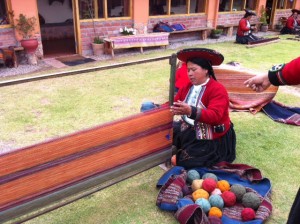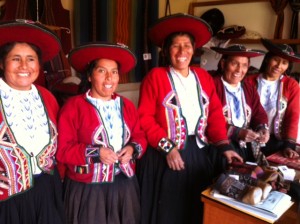On my recent adventure to Peru, I had the opportunity to visit a traditional weaving community in an ancient Andean village. Chincero is one of several small communities located throughout Southern Peru supported by the Center for Traditional Textiles of Cusco. The center is a hub for cultural and technical interchange among weavers, and promotes community textiles and economic development. The non-profit program is self-sustainable and has become so successful it is now a model for other countries to follow. National Geographic featured the program in 2002.
The center was founded by a true visionary, Nilda Callañaupa Alvarez. Recognizing early on that women in this area were discriminated against, she saw an opportunity to market the intricate pieces handcrafted by the Incan women using centuries-old traditional techniques. An expert weaver and college graduate, she was the first person in her village of Chincero to go to a university. Nilda viewed her education as an obligation to return and help her community. In 1996, she founded the Center for Traditional Textiles of Cusco, a non-profit organization to study and preserve weaving traditions in the southern Andes.
I was fortunate to speak with Nilda the day I visited Chincero. She told me she always felt good about supporting women because she could be sure the money would go back into the families. The 650+ women weavers associated with the center retain 80% of the proceeds from their work. They earn three times the minimum wage and are highly respected in their communities. What great role models for the young girls!
If you are a sustainable textile enthusiast, I recommend Nilda’s book Weaving in the Peruvian Highlands. The book features traditional Andean designs and detailed descriptions of how the textiles are woven and dyed. The all-natural dyes are derived from flowers, leaves, nuts, roots, fruits, and even insects!


